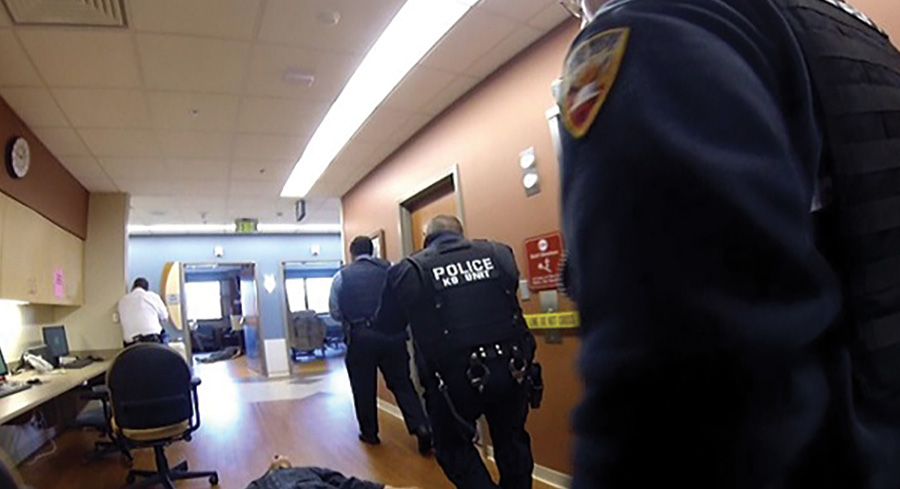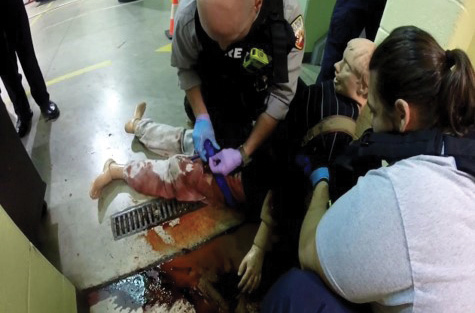By MARK LITWINKO
For many of us, the phrase “Scene safe, BSI” was engrained in our memory during our initial emergency medical services (EMS) training. But what does “scene safe” really mean? No scene is totally safe, but for some of us, our role in EMS requires us to operate in austere environments. We do so with a safety net of training, tactics, and equipment.

(1) Police officers as security detail for Rescue Task Force Team 1. (Photos by author.)
Traditional EMS protocols and guidelines often limit us from providing adequate patient care during perceived “high-threat” incidents. Active shooter events, improvised explosive device detonations, rioting, acts of violence against public safety—all of these incidents are becoming all too common for emergency service responders.
During the Columbine High School shootings in 1999, it took more than two hours until medical care was rendered to victims inside the building. For some victims, two hours was too long. In the succeeding 20 years, the public safety approach to high-threat incidents has undergone significant change. The first changes were seen in law enforcement; they no longer wait at the perimeter for specialized units to arrive on scene to manage high-threat incidents. Their shift to a very aggressive initial response has resulted in a significantly decreased amount of time needed to bring these situations under control. In essence, this change was necessary to “stop the killing.”
- Active Threat/Active Shooter Revisited
- Training Minutes: The Rescue Task Force Concept
- Tactical Emergency Casualty Care for High-Threat Environments
- EMS Response to the Active Shooter
- Active Shooter Response: Rescue in the Warm Zone
The next paradigm change lay in the hands of fire and EMS personnel to “stop the dying.” This objective gave rise to the Rescue Task Force (RTF) concept, a framework of risk-benefit analyses and combat-proven, evidence-based medicine that allowed for a point of wounded care. This saves crucial seconds and extends the “life clock” of the injured until further definitive care is available.
Spend time researching and learning about patient care during high-threat incidents and you’ll come across an 1898 quote from Dr. Nicholas Senn, founder of the Association of Military Surgeons of the United States: “The fate of the wounded lies in the hands of those who apply the first dressing.” This 120-year-old quote still holds true today. It is probably important for us to expand on that quote by addressing time.
The Time Issue
How quickly can we apply those first dressings? Many fire/EMS agencies have begun incorporating the RTF concept and are working collectively with law enforcement assets to enter unsecured areas to provide quicker care to the wounded. But, can we really enter unsecured areas to provide patient care? Yes; with the right training, tactics, and equipment, we can provide care in a “warm zone.” To do so effectively, we need to embrace the aggressive, effective, and proven medical care concepts and guidelines of Tactical Emergency Casualty Care (TECC) set in place by the Committee for Tactical Emergency Casualty Care.

(2) A firefighter places a tourniquet on a rescue manikin during Rescue Task Force Team training.
TECC is a civilian-based first responder trauma care set of principles adopted from the military medical doctrine of Tactical Combat Casualty Care. EMS is no stranger to taking tested treatments and medicine from the military and applying them appropriately to the civilian setting. These aggressive life-saving protocols bridge the gap left by traditional EMS protocols when working in high-threat environments. They allow medics to weigh the option of what they must do against what they can do based on the threat level of their current environment—in other words, “the right care at the right time.” These guidelines do not alter the standard of care but rather provide battlefield proven trauma care principles that meet those standards of care based on the environment.
TECC recognizes three phases of care based on the risk vs. benefit of the threat to the provider, the victim, and the overall mission. These risk vs. benefit assessments are no different from those made on the fireground pertaining to operations that use rapid intervention crews or vent-enter-isolate-search. The three phases of care in TECC are the Direct Threat Care Phase, the Indirect Threat Care Phase, and the Evacuation Care Phase, each of which can be correlated easily to terminology widely understood in the public safety arena: hot zone, warm zone, and cold zone.
Direct Threat Care Phase/Hot Zone
This phase of care is for an environment in which there is still an active or known threat present. When operating as the RTF, fire and EMS should consider areas where law enforcement contact teams may be engaging the perpetrator as a “no-go” zone. In this phase, the priority is the elimination or mitigation of the threat to minimize the risk of further injuries and additional casualties. Medically, the only concern is that of controlling life-threatening external bleeding using tourniquets placed high and tight on bleeding extremities.
Consider this intervention only when tactically feasible; remember—“the right thing at the right time.” For some, there will be a learning curve because we simply want to provide the best medical care possible to our patients. However, in the Direct Threat Care Phase, good medicine can lead to bad tactics, which can have a catastrophic outcome for the responders, victims, and mission.
Indirect Threat Care Phase/Warm Zone
During this phase of care, mitigation of the known threat may have occurred, but unknown threats may remain. Responders must stay vigilant and have a sense of awareness of their environment. With the diminished threat level, more time will be available to provide a greater range of patient care, but it is important not to take the diminished threat for granted.
One aspect that is often missed and not addressed during TECC training is that the progression through these phases is not linear. High-threat incidents are extremely dynamic and fluid; responders must be prepared to move in and out of these phases as the situation warrants.

(3) Rescue Task Force trauma bag and ballistic vest.

(4) Police officers providing security for the Rescue Task Force Team.
With an indirect threat, responders can expand on patient care priorities using the mnemonic MARCH (Massive hemorrhage, Airway, Respiration, Circulation, Head injury/Hyperthermia), which is included in TECC courses to help prioritize patient care responsibilities. Although more time may be available, medical care providers will likely have limited equipment, which in turn may limit patient care to the basics.
Additionally, this may likely be a mass casualty situation in which the medical provider will want to do the most good for the most patients with the time and equipment he has available. Patient triage skills will be a priority in these situations; complex patient care for the seriously injured requires time and staffing.
Evacuation Care Phase/Cold Zone
In this final but very important phase of care, all previous interventions are reassessed, and any final treatments are completed before or while coordinating transport to a definitive treatment area. Within the RTF model, it is important for each agency to consider that this is most likely the first area where advanced life support (ALS) measures begin. Based on the local EMS system, this becomes an important consideration. It is imperative to ensure that personnel are trained and equipped for continued care of these critically injured persons. One tactical error to avoid is allocating ALS personnel to the first two phases and leaving the final phase without responders able to perform the needed care in an environment suitable for these more elaborate/invasive treatments.
TECC is a valuable model to assist overcoming the gap in patient care left by traditional EMS protocols when operating in a high-threat environment. TECC does not alter typical trauma care principles but instead provides guidelines that let medical providers identify life-threatening injuries and treat them aggressively and at the right time. Combine good medicine with good tactics, and everyone goes home safely.
All agencies should train their personnel in the TECC guidelines and add TECC to their standard operating procedures and protocols. Avoid the “not us, not here” mindset. As we have seen, no department is immune to responses to acts of violence. Don’t let tragedy drive your policy changes.
MARK LITWINKO is a 14-year veteran firefighter for the Fort Wayne (IN) Fire Department assigned as an engine company lieutenant, medic, and hazmat technician. Additionally, he serves as a tactical-medic for the Fort Wayne (IN) Police Department Emergency Services Team. Litwinko also works regularly for the Indiana Department of Homeland Security as an instructor for tactical emergency casualty care and the Rescue Task Force.

